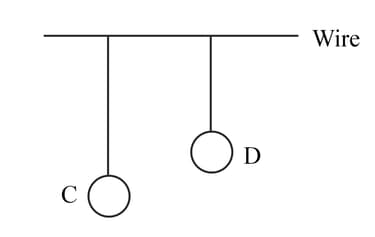A horizontal spring block system of mass execute SHM When the block is passing through its equilibrium position , an object of mass is put on it.and the two move together. Find the new amplitude and frequency of the vibration.
Important Questions on Oscillations
The amplitude of a simple pendulum, oscillating in air with a small spherical bob, decreases from 10 cm to 8 cm in 40 seconds. Assuming that Stokes law is valid, and ratio of the coefficient of viscosity of air to that of carbon dioxide is 1.3, the time in which amplitude of this pendulum will reduce from 10 cm to 5 cm in carbondioxide will be close to (ln 5 = 1.601, ln 2 = 0.693).
A pendulum with the time period of is losing energy due to damping. At a certain time, its energy is . If after completing oscillations its energy has become , then its damping constant (in ) will be
Two pendulums and are suspended from a wire as shown in the given figure. Pendulum is made to oscillate by displacing it from its mean position. It is seen that also starts oscillating. Name the type of oscillation, will execute.

Describe an illustration of free, forced and resonant oscillations.
Describes the oscillatory motion of body in a dissipative medium under the influence of a periodic force, then the state of maximum amplitude of the oscillation is a phenomena of
If the amplitude of the particle is maximum for and the energy of the particle is maximum for then
What is forced oscillation? Derive an expression for the amplitude of a forced oscillator when the driving frequency is far from its natural frequency.
.

